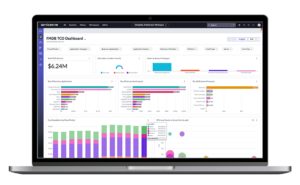In nearly every company that does IT financial management (ITFM), the starting point is Excel. In a way, it makes sense. Excel is a universal tool, it’s cheap, and in theory, you should be able to build anything with a spreadsheet.
You see this in many industries, like the Formula 1 team that used Excel to track and manage more than 20,000 automotive parts. The problem is that as complexity grows, companies eventually hit a breaking point where spreadsheets become too unwieldy to be effective. In the case of the Formula 1 team, it meant missing pre-season testing, among other failures.
With ITFM, organizations often find themselves spending huge amounts of money on data management—all without delivering the insights they truly need.
Let’s look at why this happens, and how one company discovered just how much money it was wasting by using Excel for ITFM.
Download your free eBook on 4 Steps to a Healthier ITFM Practice Beyond Spreadsheets to learn how to tell when you’ve outgrown Excel for ITFM
The Problem with Excel
If you’re at the beginning of your ITFM journey, on the surface it may seem like everything is working fine.
The issue is this:
ITFM requires a solid foundation in data management. Whether you’re looking to demonstrate IT value or increase efficiency, achieving those goals requires weaving together data from a multitude of sources.
You also need to be able to link that data together in a thoughtful way—something Excel simply wasn’t built for.
Moreover, as the organization grows and cuts increasingly bigger checks to IT, the more questions arise about where, exactly, that money is being spent. This, in turn, requires you to attempt more sophisticated modeling in Excel, which just pours gasoline on the fire.
In this sense, using Excel to manage ITFM is like an imploding star, where the system keeps getting bigger and bigger until eventually, the entire thing implodes on itself.
From Complexity to Insight
A multi-billion-dollar manufacturer recently conducted an internal analysis and discovered they were spending a full $2M annually on labor to manage their IT forecasting process in Excel. Like many companies, they had built a complex ITFM process on spreadsheets, only to find that it wasn’t producing the results they needed.
One element they struggled with in particular was that they were bringing in dollars from their corporate finance system. This required each cost center to manually split out their costs in Excel to understand where those dollars were spent.
From there, the cost data was then aggregated back by business unit, losing all transparency and the ability to appropriately share costs across the organization. When business leaders had questions about where money was being spent, it would take the CIO six weeks to get them answers.
What IT leadership wanted was the ability to have productive conversations and drive faster, more informed decision-making within the business based on:
- Precise decision levers that connect to their goals
- What the full IT footprint looks like
- Where to invest and where to cut to optimize IT spending
They ultimately decided to implement Nicus to reduce the effort required around forecasting and planning. The result has been an estimated 80% reduction in labor required for those activities—$1.6M dollars that are now available for more strategic work like analytics, optimization, and decisioning. More importantly, IT leadership can now leverage the full benefits of ITFM to drive those more productive conversations for better IT outcomes.
Hidden Business Continuity Risks
Moving beyond Excel is about more than just being more efficient in the day-to-day running of ITFM. In fact, it’s a strategic imperative for companies that want to ensure the continuity of their ITFM practice in the long term.
That’s because in any organization that has built a complex model around Excel, there’s always one Excel expert or “spreadsheet jockey” the company relies on to run it. At some point, you can be certain that person will leave the organization, putting ITFM as a whole at risk.
Deploying Nicus software to automate the manual effort involved with ITFM eliminates that risk. With the acquisition of Proven FM, Nicus now also offers data management as a service to further reduce the complexity of ITFM, with expert teams to handle activities such as:
- Connecting all the necessary data sources to Nicus software
- Processing the data appropriately
- Validating the accuracy of the results
What this means is that business leaders can get the answers they need immediately, so they can make better decisions with full transparency into IT spending. Equally important, people have the tools to answer their questions themselves by simply going to their dashboard, without bogging down IT with questions.
In the end, these are capabilities that Excel will never be able to provide, no matter how much time, money, and effort you pour into it.
Download a free eBook on Dispelling the 8 Biggest ITFM & TBM Misconceptions







